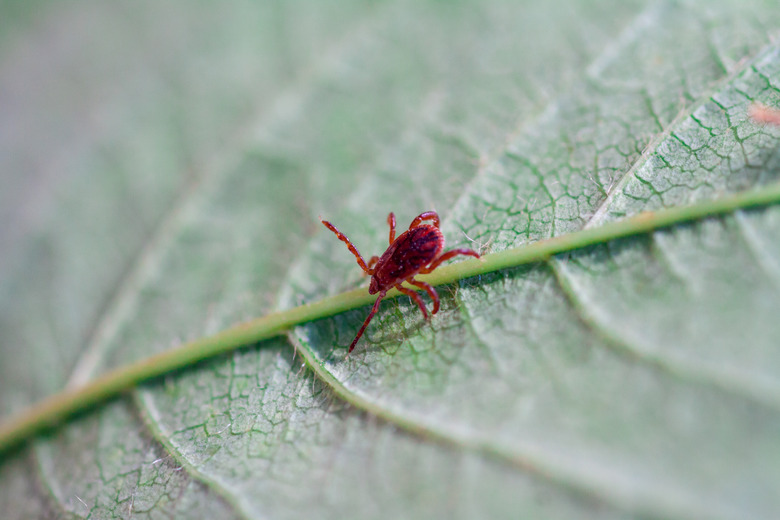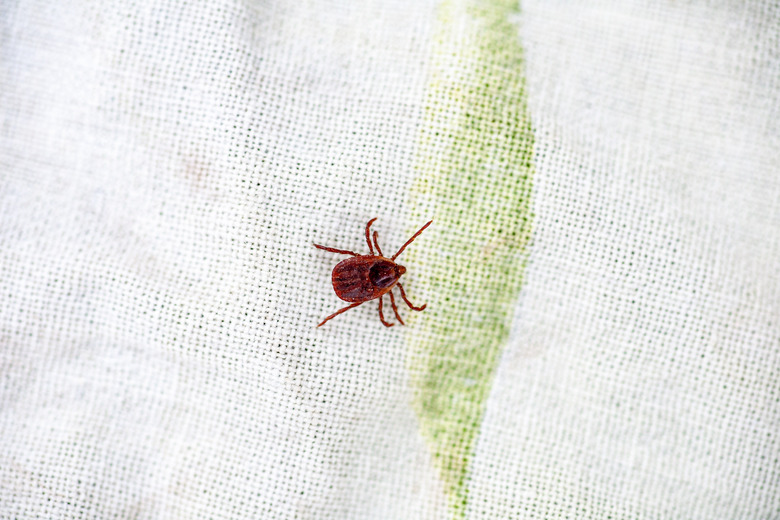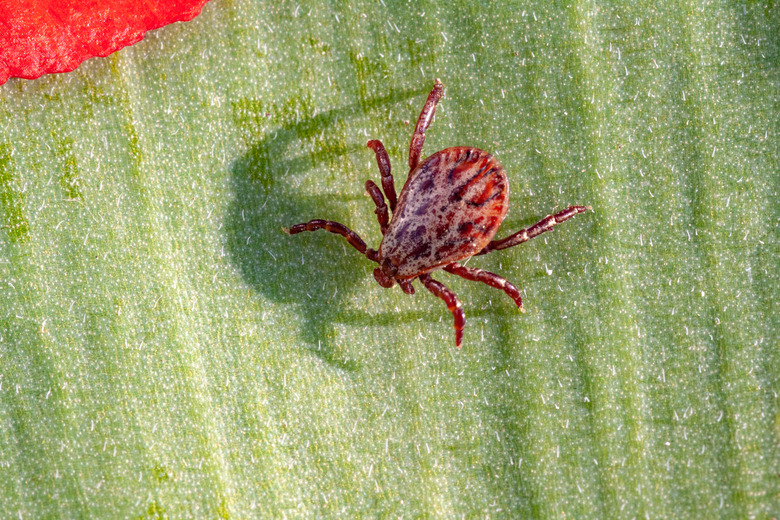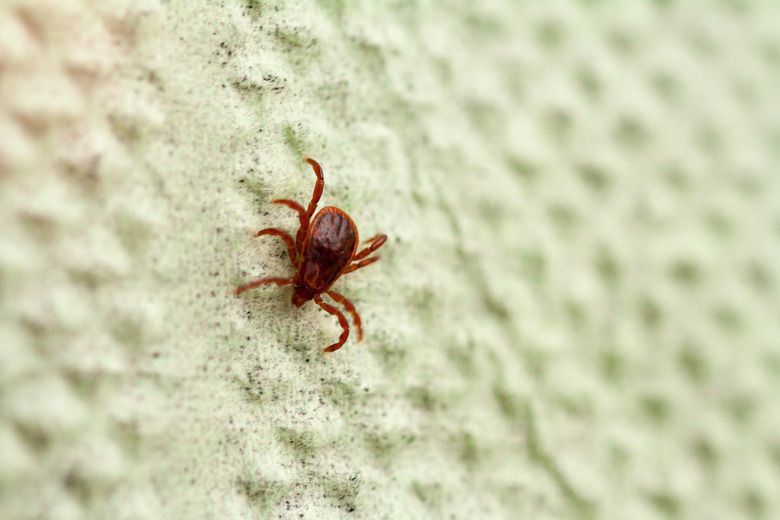How To Get Rid Of Chiggers In The Yard
We may receive a commission on purchases made from links.
It's unlikely that you've ever thought about how to get rid of chiggers (the nearly microscopic pests in your yard) until you've experienced the persistent itching and raised, red, weltlike marks on your body after a day of gardening or playing with your kids outside. Though tiny, chiggers (Trombicula spp.), which are the larval stage of mites, can cause a lot of damage. Chiggers attach themselves to a host, such as small rodents, birds, snakes, and humans, to feed on skin cells.
When your yard seems to be infested with these itchy pests, determining how to get rid of chiggers often leads to a two-prong approach. The first action is to make your yard inhospitable to chiggers. The second is to make yourself less inviting to the pests. The alternative, which isn't always practical, involves the use of pesticides, either chemical or more natural products.
What Do Chiggers Look Like?
What Do Chiggers Look Like?
- Species name: Trombicula spp. There are many species found in the United States, but the most common are Trombicula alfreddugesi and Trombicula splendens. Common names for chiggers include red bugs, harvest mites, and berry mites.
- Physical characteristics: They
are about 1/150th of an inch and are bright red or orange. Chiggers look
like little crabs with six legs. When they reach adulthood, they will
have eight legs.
- Wings or wingless? Wingless. They get around by crawling and latching onto a host for feeding.
- Life cycle: As with ticks and spiders, chiggers go through four stages: egg, larva, nymph, and adult. Only the larvae feed on skin cells.
- How to tell apart from lookalikes: Many people confuse chiggers and ticks because both feed on animals.
Ticks are larger, and they are usually brown, although adults also have
eight legs. Ticks do suck the blood of their hosts, while chiggers
digest skin cells. Ticks can transmit diseases, such as Lyme disease.
Chiggers found in North America are not known to transmit diseases.
How to Get Rid of Chiggers
How to Get Rid of Chiggers
There are plenty of do-it-yourself ways that you can eliminate pockets of chiggers in the yard as well as ways to prevent them from being attracted to you. Many effective methods involve using organic pest control products rather than synthetic chemicals often found in insecticides and bug repellents.
Determine Where They Are Located
Because chiggers tend to cluster in groups, their population density can vary from area to area, even in a small yard. Determine where the chiggers are located by placing small sections of black cardboard upright around the yard. The chiggers will climb to the top of the cardboard, and you will be able to see them against the black background because they are red.
Try Diatomaceous Earth
If you know where the chiggers are concentrated, you can dust the area with diatomaceous earth (DE), which is the fossilized remains of diatoms. It is relatively safe for humans and pets as well as plants, but it is a nose, lung, eye, and skin irritant, so be careful to limit direct exposure and avoid breathing the dust. This powdery substance damages the exoskeletons of the chiggers by drying them out.
Use Beneficial Insects
Just like every other creature, chiggers have natural enemies that want to eat them. Introducing beneficial insects into your garden may help keep chiggers and mites under control. Some insects, such as leafhopper assassin bugs, eat mites.
There is also some discussion that beneficial nematodes, which tend to favor larvae, will attack chiggers. Nematodes are microscopic organisms that kill a variety of garden pests but do not damage the soil or harm things like earthworms and beneficial insects. You can buy them online or through a garden center that specializes in organic gardening. Discuss your needs with someone from the garden center because some types of nematodes are picky about which pests they will attack.
Tend to Your Lawn and Garden
Chiggers like overgrown areas, so when drawing up a battle plan for how to get rid of chiggers, tend to your lawn and garden. Pay attention to dense, damp thickets of bushes and shrubs by pruning and weeding. Be sure to mow and keep your grass short, especially around borders where the lawn butts up against a wooded area. Chiggers don't like direct sunlight, and tall grass provides shady areas for them. Be strict about performing yard maintenance, such as removing leaves and other debris and keeping flower beds neat and weed-free.
Keep Hosts Out of Your Yard
Try to keep possible chigger hosts, such as reptiles and small mammals, out of your yard. It may not be entirely possible to achieve this, but limiting the food source will force the mites to go elsewhere. Keep lids on trash cans and, if necessary, use integrated pest management controls to limit wildlife on your property.
Use a Pesticide as a Last Resort
Using a commercial insecticide designed to kill mites and chiggers can be effective over a small area, although repeat applications will be necessary. Because they confine themselves to a small area, spraying an entire lawn is usually impractical and unnecessary. Repeat applications are often necessary because three to five generations of mites (and their subsequent chiggers) can be produced over the warm-weather months.
Be sure to follow the directions on the container. You can also get more information on chigger control from your county extension office.
Homemade Chigger Repellent
Chiggers shy away from smelly stuff. You can concoct a bug spray that includes a variety of essential oils. They seem to dislike clove, lemongrass, and citronella, among others. You can mix up a batch and pour it into a spray bottle. Try different combinations to see what works best.
A homemade chigger repellent that has been used for years is called the sulphur sock. Basically, you fill an old sock with sulphur — a standard garden amendment — and then bump the sock on your pant legs and shoe tops. Chiggers are repelled by the smell.
When to Hire a Pro
When to Hire a Pro
If you have tried everything else but are still bothered by the pests, consider calling in a professional pest management company. The pro has access to pesticides that are not available to the general public, and they have the experience to find and destroy chigger habitats. But, you should temper your expectations because it will likely take multiple visits to deal with your chigger problem.
Pest management companies should be licensed by the state, and they should use only pesticides registered with the U.S. Environmental Protection Agency. Ask the contractor how pesticides will affect plants, children, and pets. Expect to pay $75 to $200 per visit, and multiple visits will be necessary.
Where Chiggers Come From
Where Chiggers Come From
Chiggers are the larval stage of a mite — so though they can wreak plenty of havoc before they reach maturity, chiggers will be present when there are adult mites in the yard.
Adult mites begin laying eggs in early spring when the temperature reaches about 70 degrees Fahrenheit. They lay the eggs in clusters, and the larvae do not stray far from their birth places. They crawl around on the soil, grass blades, weeds, and the like until they find a host to latch onto.
Do Chiggers Cause Damage or Spread Disease?
Do Chiggers Cause Damage or Spread Disease?
Chiggers are arachnids, closely related to ticks and spiders, and many people believe that chiggers burrow under the exposed skin of their victims. But actually, their saliva produces enzymes that break down the cells of the skin. It's that bite and feeding that causes the itch and the welts, which can last for up to two weeks. Fortunately, aside from the itching, the bites are relatively harmless. Chiggers do not carry or transmit diseases, although the constant scratching of the welts could lead to an infection.
Aside from the itching and the welts, chiggers do not cause long-term damage to the host. Even if you didn't bathe or scratch the itch, the chigger would drop off you after about three days. It would then move into the nymph stage of development.
There are remedies for the discomfort of the chigger bites and the resulting welts on the skin. Pets that are hosts for chiggers will usually scratch to remove them, although like humans, they may be uncomfortable. If the pet seems to be in distress, seek the advice of a veterinarian.
Chiggers grow into mites that usually feed on the eggs of other insects. This could be beneficial, as they may feed on mosquito eggs or the eggs of other pests. Unlike spider mites, these types of mites are not known to harm ornamental plants or crops.
How to Protect Yourself from Chigger Bites
How to Protect Yourself from Chigger Bites
If you know where chigger clusters are located, avoid sitting or lying in the grass and don't let children play in that area. When venturing outdoors, wear long pants and long-sleeve shirts and tuck the bottom of your pants into the top of your socks or high boots.
When you suspect you may have been near chiggers (i.e. walking through thick grass or bushes), brush off your clothes as best you can and throw them into the washing machine. You should take a warm bath or shower and use plenty of soap. This will remove chiggers from your skin.
You can also apply a bug repellent to keep the critters off your body. Over-the-counter products that contain DEET (N.N-dimethyl-3-benzamide) work best. You will see products with different percentages of DEET in the formulations. The higher levels do not perform any better than lower levels; they just last longer. So, 10 percent DEET will keep bugs away for about two hours, while 25 percent will last up to five hours.
While many insect repellents can be applied directly to your skin, others are designed for clothing, lawn furniture, and camping gear. Follow the directions on the product. Generally, they can be used on clothing, boots, tents, sleeping bags, backpacks, and the like.



